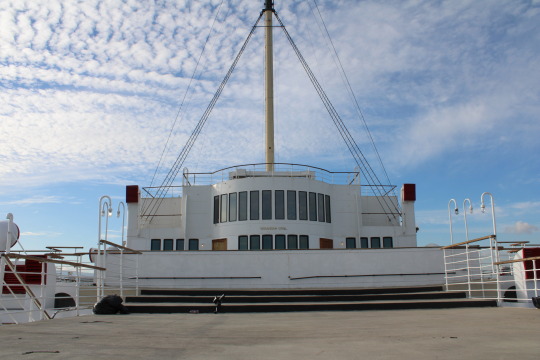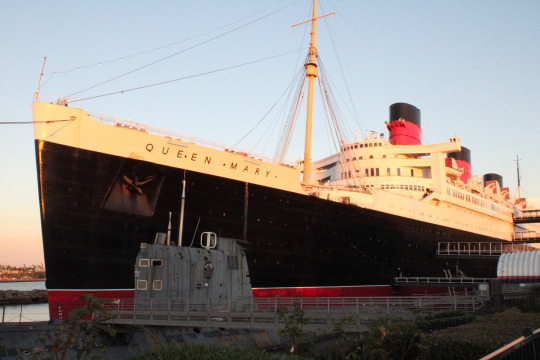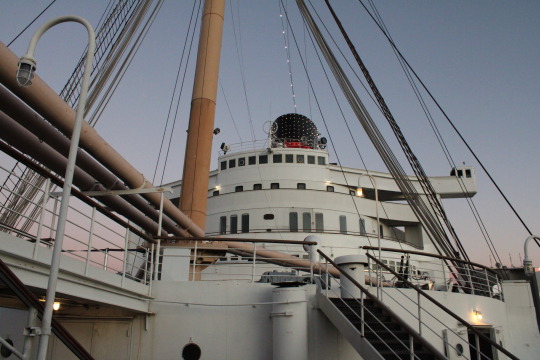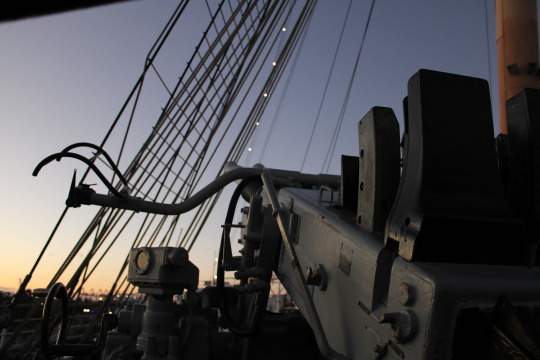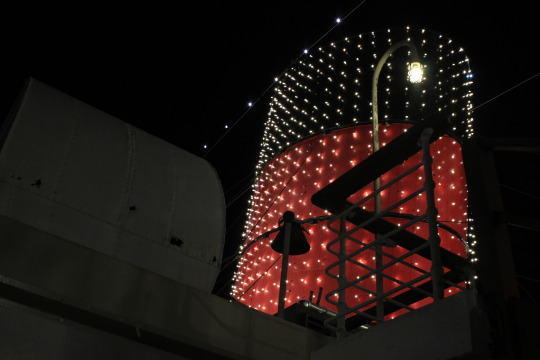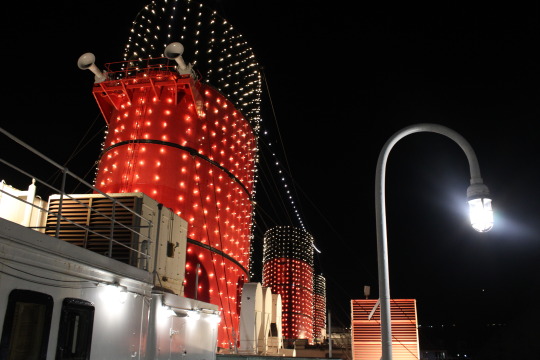#rms queen mary
Text

queen mary on war service, thousands of men on deck
postcard ca. 1946-47
the mary was a crucial troop transport ship during wwii; she carried up to 15,000 troops on crossings, and could carry as many as 16,683 (the most passengers ever transported on a single ship, crew included). she received the nickname "the grey ghost" because of her wartime paint and sheer speed.
#postcard#postcards#ocean liners#rms queen mary#cunard line#cunard white star#wwii#1940s#i really dont care about war history except for liners' contributions. which are very fascinating to me
42 notes
·
View notes
Text

RMS Queen Mary - Southampton, England; 1936
26 notes
·
View notes
Text
Excuse me that’s my emotional support ocean liner 😔
38 notes
·
View notes
Text

The Queen on her last voyage from Southampton in 1967.
14 notes
·
View notes
Note
something about your blog seems to have changed but I can't quite put my finger on what :3
p.s. what would you say is the worst liner, looks wise
I got a new icon :3
And as for your question, there's a couple of ways I could answer this. There are probably thousands of no-name liners that no one's really ever heard of, so the answer is probably one of those, but I wouldn't have any way to know. Instead, let's have some fun with more of the "popular" choices.

Number one would be the SS Johan Van Oldenbarnevelt. She's become something of a meme is this niche little boat community for having a mouthful of a name and a relatively unpleasant exterior. Her superstructure is much too tall, her funnels are too short and too far back, and her hull has comparatively little freeboard (distance between the water and the bottom of the superstructure). Later in her life, she was refit as a cruise ship, and she looked surprisingly better.
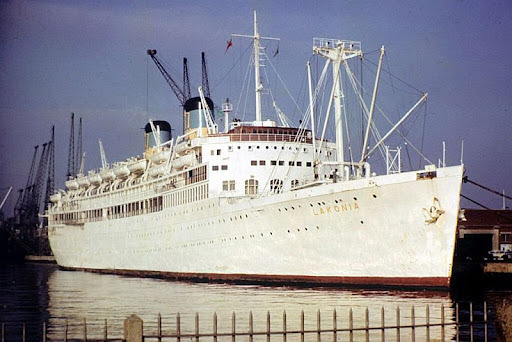
As you can see, they made her funnels taller, and the lack of freeboard is much less noticeable while painted white.
As for my second choice, this one is extremely controversial.

I'm not a fan of the Normandie, and one of those reasons is her exterior. My two big things are the funnels and the shape of the bow. The funnels are too big. I think if they were shorter OR thinner, they would have looked much better. The MV Georgic was able to pull off the short funnels surprisingly well, and here's a pic for reference.

Now, my second point, her bow. I think this picture says it all.

It just looks so ugly to me. I think if the white part had continued all the way forward instead of like, swooping down and stopping, she would have looked fine. I think without the issues with her funnels, and without the weird bow shape, she'd be one of my favorites (at least externally).
Before this ends, I should admit some bias. In the Ocean Liner community, there is a Neverending Twilight esque battle between Normandie fans and Queen Mary fans. This is because the two ships traded the speed record back and forth several times, and were both being regularly being refit to be bigger than the other. I don't think competition between liners has existed like this before or since. Personally, I'm team Queen Mary, which I'd rather dedicate a separate post to, because there's a lot to go over. So, with all that being said, I MAY have a slight bias against the Normandie. With that being said, I'm still just not a fan of the way she looks.
#ocean liner#ocean liners#oceanliner#cunard#cruise ship#rms queen mary#ss Normandie#ss Johan Van Oldenbarnavelt
26 notes
·
View notes
Text

Thousands of U.S. troops arriving in New York from Europe on the Queen Mary, June 20, 1945. The RMS Queen Mary was launched in 1934 as a Cunard-White Star liner and was converted to a troopship during World War II.
Photo: U.S. Navy/Science Photo Library/Fine Art America
#vintage New York#1940s#World War II#color photography#returning troops#June 20#20 June#RMS Queen Mary#vintage NYC#Manhattan skyline#ocean liners
57 notes
·
View notes
Text

Behold, the true monarch of the ocean: RMS Queen Mary! She may well be the world’s most beloved ocean liner barring, of course, Titanic; her existence has touched lives the world over and she continues to be a cultural staple today. She’s high up on my list of favorite ships, and as such I decided to draw her not as a gijinka, not in her current hotel-slash-attraction form, but as the record-breaking liner she was built to be. Here she is, thundering across the waves, racing the sky itself as she sets a new speed record for Britain and Cunard.
And, of course, here are the notes:
I started this drawing more than a year and a half ago, in the spring of my first year at college. For context, as of posting this it’s the fall semester of my third year, so quite a bit of time has passed. The piece was stalled for so long because coloring the hull was so daunting - I didn’t want to mess anything up, and I knew it would require a lot of graphite!
Originally, this was going to be a fully inked and colored piece. However, the way I shaded the hawsepipe and the top of the funnel just looked too nice to erase or color over, so I switched to making it a pencil-only piece instead.
Despite how realistic I made the drawing, there are some elements that are missing or otherwise incorrect. The horizonal poles (which I believe are cargo booms) attached to the foremast are absent; you should be able to see one of them from this angle, but I left it out because, when I first started the drawing, I wanted to simplify things slightly. I ultimately changed my mind, but by then it was too late in the process to add that in. That’s also the case with the simplified instruments on top of the bridge.
The rigging is simplified, but I tried to be accurate with the stuff I did add.
I made the smoke and water look like that by coloring them in normally and then smudging the pencil with my fingers. Then I added darker areas in the smoke for shading, and finally I used an eraser to make the lighter parts in both the smoke and water. Realistically, Queen Mary wouldn’t have actually produced such a dramatic smoke plume, as she was an oil-fired ship rather than a coal-fired one, but the bigger cloud looked cooler and more dynamic. Also, the smoke should be blowing backward, but it isn’t for similar artistic-license reasons; this, at least, can be explained by saying she must be sailing in some pretty strong wind!
I was originally planning to smudge the hull too in order to smooth out the coloring, but I changed my mind.
I based the drawing on this photograph!
#noodles draws#traditional art#ocean liner#rms queen mary#pencil drawing#i cannot stress enough this took fucking forever
23 notes
·
View notes
Text

26 notes
·
View notes
Text
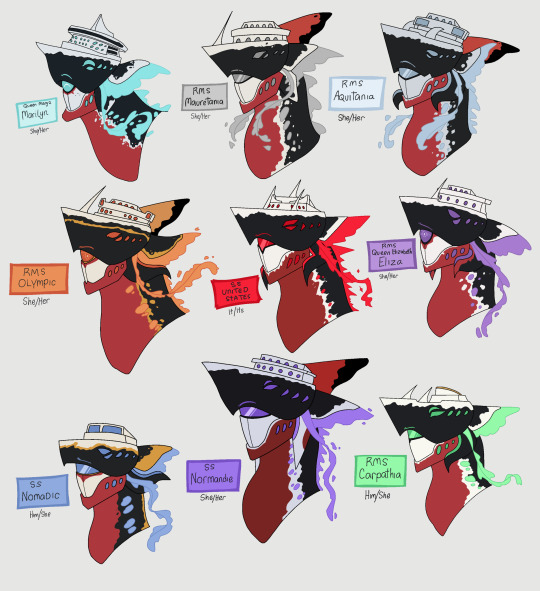
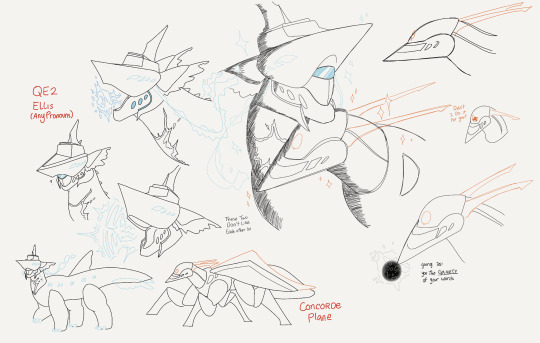
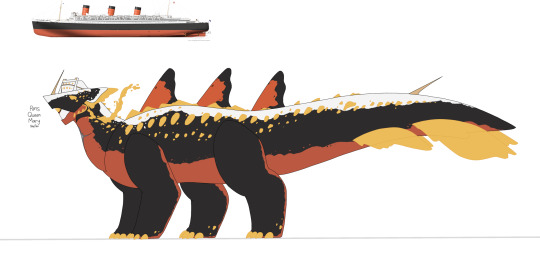
Get Boat’d
(reference pic credit to oceanliner designs)
#core’s art#re:t0ld#locomotion#ocean liners#QM2#RMS Mauretania#RMS Aquitania#RMS Olympic#SS United States#RMS Queen Elizabeth#SS Nomadic#SS Normandie#RMS Carpathia#RMS Queen Mary#cameo from Concorde
45 notes
·
View notes
Text
so i have a soft spot for the 2006 film poseidon which is a film i reckon about 24 other people remember existing since warner bros lost like $70million on it, and i just like, need to talk about it.
its a loose remake of a 1972 film, and overall, its a very silly film, however its also connected to massive advancements in oceanography, and through that connection, also connected to an incident that could have killed around 10000 american recruits during ww2 in less than an hour.
and i cannot stop thinking about this stupid film so please enjoy this stupidly long post no one is going to read because I Need To Infodump.
so poseidon (2006)...
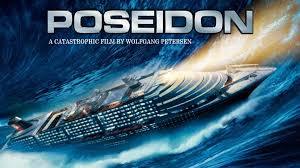
it's a very of its time disaster film with your group of plucky survivors trying to overcome more and more obstacles as they desperately fight for safety. among them, youve got kurt russell as an ex nyc firefighter and mayor because its 2006, of course you do. emmy rossums here because of course she is (again, its 2006), and surprise richard dreyfus is here as a gay naval architect who survives the film. fergie even has a cameo and its honestly a crime that the song she sings for it is not on spotify.
but the film is also very much not a of its time disaster film, because production decided to not update the setting. and i have absolutely no idea why. and its confused me for years now because its an easy fix.
see the 1972 film (the poseidon adventure) and the book its based on, both take place on an ocean liner, and that makes sense for that time.
contrary to popular beliefs, ocean liners =/= cruise ships.
during the late 19th century and most of the 20th century, ocean liners were all the rage, because if you wanted to go from liverpool to new york, they were your best bet.
with the invention of steam engines, they were no longer dependent on weather, and once wood was swapped for steel, they were at serious less risk of sinking. this meant they could run reliable trips from point a to point b and back again. they were essentially buses for the ocean. thats what titanic was btw.
while less popular due to jet travel in the 70s, people were still using them. the ss michelangelo sailed her maiden voyage in 1965, and ran for ten years still. it does make sense for both the book and film to take place on an ocean liner.
it does not make sense for the 2006 iteration to take place on an ocean liner, but it does. and its not even an ocean liner turned cruise ship like the rms queen mary 2 or the ss france/ss norway. there were no ocean liner only businesses operating in 2006 because you can now take a plane rather than a five day trip across the atlantic.
but in poseidon (2006), the rms poseidon is not a cruise ship. it is an ocean liner, and designating it as rms means it is also delivering international royal mail. theres even a plot about a stowaway aboard the ship which is just a tad bit bizarre. its such an odd choice not to simply update it so its a cruise ship. most people dont know the difference between them, theres no reason to specify that it is an ocean liner.
(its especially odd because the gay naval architect apparently knows the vessel very well which, sir, who is paying you to draft up ocean liner designs in 2006??)
weirdly enough though, the film does decide to update the actual cause for the disaster, which will bring us back to the ww2 point.
the general gist of the story is that some environmental event causes the ship to capsize (turn upside down in the water), and our heroes have to escape the ship.
i have attempted to read the book, but i didnt enjoy it and i was getting a feeling that the author, paul gallico, was antisemitic. he was. he specifically expressed it by saying jewish folks love basketball because its a game specialised for tricky characters, to paraphrase. yeah no theres also basketball antisemitism going on.
in the book, its an underwater earthquake that causes the ship to capsize. the quake created a 90ft wave (put a pin in that, we'll get back to it) which i believe hit the ship side-on, after the ship fell into a deep trough.
i have no idea if this is possible irl as im just an autistic with a special interest in ocean liners.
in the 1972 film, its a tsunami that hits the ship. i believe the tsunami is also caused by an underwater earthquake (again, put a pin in that) which would hit the ship on the side and cause it to roll right over (put a pin in this too btw).
again, i dont know about the veracity of this happening irl. i know tsunamis are related to underwater earthquakes, but as far as i know, they dont form into the massive wave until the wave is closer to shore?
but anyway, in the 2006 film, the capsizing is caused by a rogue wave.
as aforementioned, my special interest is ocean liners so i know quite a lot about rogue waves and i dont know how much of that is common knowledge so time for another abrupt explanation of niche topics.
so rogue waves, what are they? well, theyre big fuck off waves. descriptions tend to put them anywhere from 50ft high to 100ft (10 stories high).
for a wave to be considered a rogue wave, it needs to be more than twice the height of any other wave in that region. theyre unpredictable and often occur out of nowhere. theyre more common in some specific regions like off the coast of south africa, and are distinct from tsunamis. they can occur both in the ocean and on the great lakes.
for centuries, sailors have told tales of them but like krakens and sea monsters, they werent believed. this is partly due to survivorship bias because if youre in a wooden sailboat and get hit by a rogue wave, youre not going to survive. it was only after advancements in ship building that people began to survive them. and even then, its not guaranteed.
some theorise rogue waves were responsible for the sinking of both the ss munich/munchen and the edmund fitzgerald.
still, it wasnt until one was recorded by a research post in 1995 that rogue waves genuinely became a serious topic within oceanography.
however, we did have credible reports of them hitting ocean liners long before then. both the rms lusitania (in 1910) and the ss michelangelo (in 1966) were badly damaged when they ran into rogue waves bow first (head-on). they both fell into deep troughs before the wave hit and both of their bows sustained serious damage. three people lost their lives on the ss michelangelo.
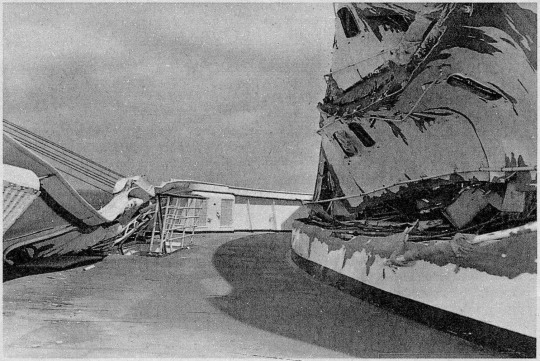
(damage done to ss michelangelo)
despite this, it was preferable for both vessels to hit the wave head-on. both were ocean liners with bows designed to break through waves, and designed to be able to keep sailing even if the bow was caved in.
(fun fact: if titanic had hit the iceberg head on, there was a very good chance she wouldnt have sunk)
now you might want to know why we know it was preferable to be hit head-on, and why i specified the ship would have been hit side-on. this is how the ship was hit in the 2006 film also. and well, this is when were getting into ww2 territory.
the lusitania and michelangelo are not the only ocean liners to encounter a rogue wave. this also happened to the rms queen mary in 1942.
just some quick background on the queen mary; she was launched in 1936 and built with the goal of stealing the blue riband (the record for fastest journey for a passenger line from southampton to new york) from the ss normandie, owned by french line. queen mary was owned by the cunard line whose reputation partly rested on speed. both the lusitania and mauritania (both cunard ships) had won the blue riband at some point. in 1942, queen mary held the blue riband and was considered the fastest passenger liner in the world.

at that point though, she has been requisitioned by the admiralty for the war effort and was acting as a troop ship. a very effective troop ship as she averaged 28 knots in speed and they managed to up her capacity from around 3300 (including crew) to 16000.
she also was owned by cunard line who have a long history of conferring with the admiralty during peacetimes. their ships were designed with spaces left for guns and weapons. part of why the lusitania was sunk by a u-boat in ww1 was her secretly carrying firearms back from the "neutral" america to the uk despite it still being a passenger ship. the admiralty knew queen mary would be a massive benefit in a war.
this isnt to say that she was perfect, however. she was a famous roller. see, when youre building a ship, you expect it to roll somewhat on any difficult seas. to combat extreme rolling (which can be fatal), ships are built with their centres of buoyancy and gravity close together. this reduces rolling, but can cause very sudden lists (tilts). as queen mary was a big fuck off ship, it was assumed she wouldnt roll badly, so she was designed with a slightly bigger gap between those centres which caused very slow rolling from side to side. this often felt like the ship would never right itself, and as handrails were not considered necessary at first, passengers had to shuffle down hallways.
cunard took her in for repairs and added stabilisers to lessen the roll. they also added handrails. it didnt fix the rolling, but it was bearable and not considered dangerous. she soon became a superstar liner, and again, a very good troop ship.
hitler had even put a monetary bounty specifically on the queen mary for whichever submarine could shoot her, with the iron cross promised also. this did not come to pass.

(rms queen mary as a troopship)
what did come to pass, however, was a 92ft high rogue wave smashing into her portside (left). this is the absolute opposite of what you want to happen.
there was an attempt to steer her head-on into the wave but ocean liners that size take two miles to stop moving. they also couldnt risk too sudden of a turn because they were in the atlantic in a storm. this attempt to change course is repeated in the 2006 film and is also unsuccessful.
so now when the wave hit queen mary, it caused her to begin listing to starboard (right side) because a 90ft ocean wave just smashed into her. and she began to list. the portholes broke and wager poured in, making the list worst.
at first, it was 15°, then 20°, then 25°, 30°, 40°, 50°, 52°
then she stopped. and she stayed there, listing 52° to starboard. she was nearly capsized. and what must have felt like hours for those 11000 recruits and crew, she just stayed there, nearly on her side in the atlantic ocean.
and then finally, she began to right herself, one degree at a time, until she was back steady as if nothing had happened.
the technicians had later examined the ship and estimated that if shed listed just 3° extra, they would have capsized and sank, taking 11000 men with her.
so i imagine at this point, if youre even reading this anymore, youre like okay, kai, we get it, you dont wanna get hit broadside by a rogue wave, do we need all this detail?
and well, no. you dont need to know it and i dont need to tell it but here i am, telling you so.
but it is very relevant to poseidon (2006) because remember how its a remake of a film based on a book? and that book was written by the basketball antisemite? yeah, so paul gallico was on board the queen mary when this happened.
and this is what inspired him to write the book.
obviously, at the time, we didnt fully understand rogue waves so gallico explained it as an underwater earthquake, but we know now it was a rogue wave.
and so the 2006 film honours that and makes it a rogue wave. they never really explain it so unless youre insufferable like me, you might just be like what the fuck? is that poseidon (god) doing that?
but im gonna redirect your attention to the fact that the queen mary was 3° away from capsizing and that 3° could have caused an entirely different outcome to the war.
if she had capsized, she would have taken 10000 recruits with her and the allies would have lost their best troop ship. morale would have been affected because back then, ocean liners were household celebrities. they were adored by residents.
im not a historian, and especially not a war historian, so im not gonna be like oh look alternate history where the nazis won oooh how edgy?
but like, just a few more feet of water on that wave and parts of ww2 would be so different.
it also would have affected the cunard line massively after the war, and the white star line (titanics owners) as well. i believe their merger was after ww2.
also, gallico would have died so his book wouldnt have existed, neither would the film adaptation or the remake. it all just comes back around like a never ending carousel of feral seahorses.
but anyway, away from all the existential crises. i wanted to actually address what made me want to write this stupidly long post in the first place:
an article i skim read that addressed the veracity of the inciting event in the 2006 film, aka the rogue wave.
after a mostly accurate explanation of rogue waves and at least one misuse of cruise ship for ocean liner, the article concluded that a rogue wave hitting an ocean liner like that was simply so unlikely, it was basically impossible.
and if youve got this far in my ramblings, you might be able to understand the level of bafflement i felt reading that.
because while it is a fair conclusion as it is a very unlikely thing to happen. but THIS FILM EXISTS BECAUSE A ROGUE WAVE SMASHED INTO AN OCEAN LINER AND NEARLY CAPSIZED IT
#kai rambles#a lot#long post#very long post#this is just me infodumping into the void#poseidon (2006)#the poseidon adventure#tw antisemitism#rms queen mary#ss normandie#ss michelangelo#rms lusitania#rms mauritania#rms titanic#titanic#ocean liners#SpIns#ww2#rogue waves#tw adolf hitler#tw nazis#tw ww2#ss munich#edmund fitzgerald#my autism is singing sea shanties tonight lads#anyway#im glad the gay survived the action film in 2006#shipposting
31 notes
·
View notes
Text

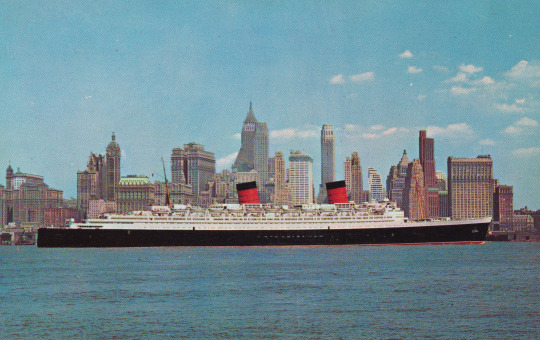

île de france, queen elizabeth, and queen mary against the new york skyline
chrome postcards ca. 1950s
#postcard#postcards#ocean liners#ss ile de france#rms queen elizabeth#rms queen mary#new york#1950s#chrome
25 notes
·
View notes
Text
31 Days of Halloween: Day 11, The RMS Queen Mary in Long Beach, California
As we embark on Day 11 of our 31 days of Halloween, we set sail for the RMS Queen Mary, an iconic ocean liner turned haunted attraction in Long Beach, California. Known for its luxurious past and ghostly inhabitants, the Queen Mary offers a unique blend of history, elegance, and spine-chilling encounters.
Historical Background
The RMS Queen Mary, launched in 1936, was a grand and glamorous ocean liner that epitomized the golden age of transatlantic travel. It served as a luxury passenger ship during peacetime and was later repurposed as a troopship during World War II. After its retirement in 1967, the Queen Mary found a new home in Long Beach, where it became a hotel and tourist attraction.
Ghostly Legends
With her rich history, the Queen Mary has garnered a reputation for being one of the most haunted places in America. Here are some of the ghostly legends associated with this imposing vessel:
The Lady in White: One of the most famous apparitions aboard the Queen Mary is the "Lady in White." Legend has it that a young woman wearing a white evening gown wanders the decks, often seen near the first-class swimming pool area. Some believe she may be the spirit of a woman who drowned on the ship.
Ghostly Children: Visitors and staff have reported encountering the ghostly spirits of children, believed to be victims of tragic accidents that occurred on board. Laughter, whispers, and the sound of bouncing balls have all been attributed to these playful apparitions.
Haunted Cabins: Some of the ship's staterooms and cabins are notorious for paranormal activity. Guests have reported unexplained footsteps, flickering lights, phantom knocks, and the feeling of being watched.
Exploring the Queen Mary
The Queen Mary offers various ways to experience its haunted halls. Visitors can take guided tours that delve into the ship's history and paranormal encounters, or they can opt for the more immersive "Ghost Tour" experience. These tours lead guests through known hotspots of paranormal activity, allowing them to delve into the ship's eerie tales and potentially encounter its ghostly inhabitants.
For those seeking an overnight stay, the Queen Mary offers a chance to sleep in one of the ship's staterooms. Some rooms are rumored to have heightened paranormal activity, offering a spine-tingling experience for those seeking a ghostly encounter.
Conclusion
On Day 11 of our Halloween journey, we have explored the RMS Queen Mary, a majestic ocean liner with a haunted reputation. From the Lady in White to the ghostly children, the Queen Mary is known for its spectral inhabitants who continue to captivate and intrigue visitors.
Whether you choose to explore the ship's haunted history during a guided tour or spend a spine-chilling night in one of its ghostly cabins, the Queen Mary promises a unique and haunting experience for all who dare to set foot on its decks. Prepare for a supernatural voyage and embrace the Halloween spirit as you embark on an adventure aboard this ghostly vessel.
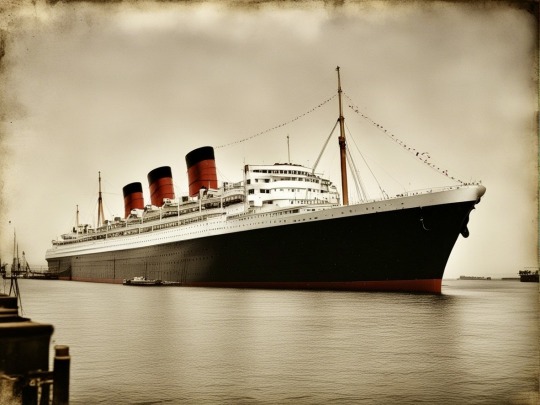
#ko-fi#kofi#geeknik#nostr#art#blog#writing#halloween#all hallows eve#samhain#31daysofhalloween#31 days of halloween#long beach#california#rms queen mary#queen mary#ship#cruise ship#cruise liner#ghosts#troop ship
4 notes
·
View notes
Text
Wishful Thinking
Headline from the New York Times on July 18, 1967:
City Hopes to Buy Queen Mary For Use as a School in Brooklyn
The city is preparing a bid of about $2-million in an effort to purchase the liner Queen Mary for use as a floating high school anchored at the old Brooklyn Navy Yard.

View On WordPress
3 notes
·
View notes
Note
what are some underrated boats that you dont think get enough love or appreciation and why?
sincerely,
#1 sailboat fan ⛵
For me, I'd say White Star Lines SS Germanic. She was 455 feet long and 5,008 Gross Registered Tons. She was delivered to the White Star Line in 1875 as the sister of the SS Britannic. These ships were largely considered to be a scaled up version of the Oceanic class from 1870, but her career is what makes her interesting to me. She had 1 propeller powered by compound steam engines, and a service speed of 16 knots (30 km/h, or 18 mph). At this speed, she and her sister won back the Blue Ribband for the White Star Line. Like the Oceanic class, she was rigged as a barque with sails in case of emergency, which came in handy when in January of 1883 her propeller shaft sheared at sea, and she had to make the rest of the journey by sail. She was the last White Star liner to be constructed primarily out of iron. After her, all of their ships were made from steel. In April of 1885, she encountered a rogue wave, which struck her and caused substantial damage. Six lifeboats had been torn away, the skylights to her engine rooms were smashed, and her pilot house was crushed. Water flooded into the boiler and engine rooms, a hole was torn into the side of the reading room, which quickly flooded (followed by the saloon and staterooms), and 13 people were injured, with one sailor being washed overboard. On 13th of February 1899, she was caught in a massive blizzard at her pier in New York. An estimated 1,800 Tons of snow and ice fell atop her superstructure. This added weight was enough to make her list enough that water could enter her open Coaling ports. She sank at her pier. She was refloated, repaired, and resumed service three months later. Starting around 1904, she changed hands numerous times, until finally landing in the Ottoman empire, and being renamed Gul Djemal / Gülcemal. She served as a troop transport until 1920, when she became a passenger ship again. She was retired from service in 1937, but wasn't scrapped until 1950. There were plans to convert her into a floating hotel (like the Queen Mary would be in 1970) but this never came to fruition. Having been in service for 75 years, she is the second longest serving ocean liner, behind Cunard Line's SS Parthia. She survived both World Wars (even though she played no part in the second World War). Her sister ship Britannic was scrapped in 1904, after serving in the Second Boer War as a troop ship.
24 notes
·
View notes
Text
Nothing made me more excited than finding out the Aquarium of the Pacific is literally within spitting distance of the Queen Mary. She gets to make a cameo in my fic 🥰
3 notes
·
View notes

